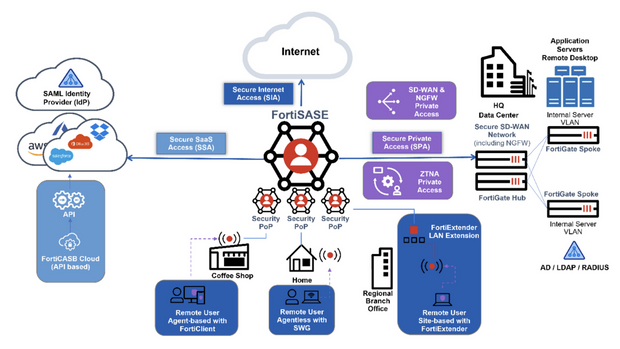In a bid to further strengthen its position as a single-vendor Secure Access Service Edge (SASE) provider, Fortinet has committed to double its investments in data centers to ensure that the user experience of customers onboarded to its cloud-native platform ‘FortiSASE’ remains uncompromised.

The FortiSASE platform offers a suite of security and networking capabilities, such as firewall, secure Web gateway, secure access gateway, software-defined wide area network (SD-WAN), and zero trust network access (ZTNA). These services are delivered as a cloud-based service, enabling organizations of all sizes to leverage on the benefits of flexibility and scalability.
“Complexity is just one aspect. When we talk about complexity, we’re not talking about just management. I think what’s important is how Fortinet can actually integrate with what you have,” said Kelvin Chua, regional systems engineering director for Fortinet Southeast Asia and Hong Kong.
The SASE architecture provides a comprehensive security framework that includes identity and access management, threat prevention, data loss prevention, and network segmentation. Based on the principles of zero trust networking, the SASE model mandates authentication and authorization for every user, device, and application before access is granted.
With flexibility and scalability at its core, this architecture enables organizations to quickly adapt to changing business requirements and scale their network and security services up or down as needed.
Additionally, SASE provides a unified view of the network and security infrastructure, simplifying management and reducing the complexity of deploying and maintaining a distributed network.
Fortinet says that single-vendor SASE, which is the provision of networking and security services by a single vendor in a unified solution, has emerged as a key example of convergence that can help teams drive operational efficiency, reduce costs by reducing the number of vendors and point products, and reduce complexity.
“We do understand that nobody will adopt everything from Fortinet technologies so we extend our portfolio to connect to the fabric partners. Right now, we have more than 400 partners connecting to Fortinet in different levels – from machine-to-machine API communications, cloud integrations, DevOps protection, and cyberthreat security,” added Peerapong Jongvibool, Fortinet VP for Southeast Asia and Hong Kong.
A recent Gartner reports says that the adoption of single-vendor SASE is predicted to rise significantly, with one-third of new SASE deployments expected to be based on a single-vendor SASE offering by 2025, compared to just 10% in 2022.
A single-vendor SASE scenario may not always be the best fit for every organization since there are some who may prefer a multi-vendor approach to building their SASE platform, allowing them to choose best-of-breed solutions from different vendors that are better suited to their specific needs.
Ultimately, the approach to building a SASE architecture depends on the specific requirements of the organization and its IT infrastructure.
According to a recent Secure Access Service Edge (SASE) research study conducted by CIO, organizations are accelerating their investments in SASE solutions due to recent trends.
The study found that SASE solutions are providing recognized benefits that exceed expectations across five key categories, with remote work connectivity and security performance being the most notable.
The study also found that 94% of respondents reported that their adoption of SASE solutions has accelerated due to the need to make digital services and hybrid work sustainable for the long term.
This highlights the importance of SASE solutions in enabling secure access to applications and data from anywhere, at any time, while also providing greater visibility, control, and automation.
The results of the study underscore the growing recognition of the importance of SASE solutions in addressing the security and networking challenges of the cloud era. As organizations continue to embrace digital transformation and hybrid work models, the adoption of SASE solutions is expected to continue to accelerate.
The Fortinet Security Fabric is specifically designed to work seamlessly with third-party security solutions, providing organizations with the ability to easily integrate their existing security tools into the Fortinet Security Fabric platform.
This integration allows organizations to achieve better visibility, control, and protection across their entire IT infrastructure, regardless of the vendor or technology utilized.
The open, standards-based architecture of the Security Fabric allows for straightforward integration with third-party security solutions – from firewalls, endpoint protection, cloud security, and more.
In addition, the Security Fabric provides APIs and SDKs that enable developers to create custom integrations and automate security workflows.
Through the integration of third-party security solutions into the Security Fabric platform, organizations can optimize their investment in existing security tools, reduce complexity, and streamline management.
The Security Fabric’s capacity to integrate with a wide variety of third-party security solutions offers a significant advantage for organizations seeking to strengthen their security posture and protect against advanced threats.




